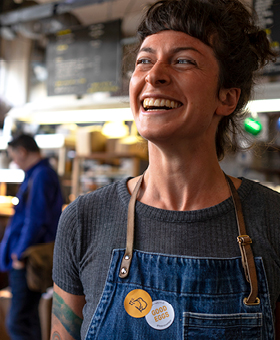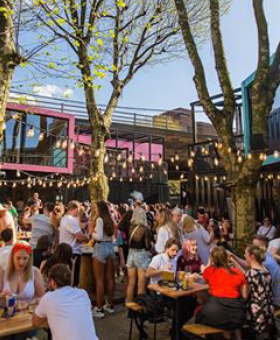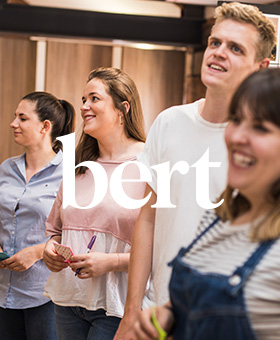Productivity, Motivation & Place
Exploring the links between where we work, why we work and how much we work
—
Have you heard the news? According to the UK Office for National Statistics, the UK’s productivity – the volume of products and services we generate in a given time period – is low. It’s lower than our global competitors. Worse still, it’s not just low, it’s getting lower.
Productivity is vital because time, as the old saying goes, is money. Strong productivity means clients and customers are getting good value. It’s a marker of economic confidence and it’s closely linked to innovation and market leadership.
So, in these uncertain times, the latest productivity numbers present unsettling questions about what’s to come. How do we make sure that the next five years are more productive than the last five? I decided to see if there’s anything we agencies can do to help turn things around.
It’s not where you’re from, it’s where you’re at
There are two ways to look at all this: the big picture (known in the jargon as macroeconomics) and the detail (called microeconomics). The macro level is where governments and central banks come in – setting interest rates, investment priorities and so on. Micro is where we’re at.
And the first factor that affects us all is our work space. Environment has a huge impact on psychology, so it stands to reason that work environment has a huge impact on productivity. With this in mind I began by devising a little experiment to discover which kinds of environment are the most work-beneficial. For me at least.
First stop: work (with hot chocolate) in a local cafe
Quiet, purposeful buzz of activity? Check. Relaxed atmosphere? Check. Subdued decor and mood lighting? Check. So far so good. Open the computer and off we go…
Research suggests that productivity is enhanced by the hum of background conversation, and there certainly seems to be something in this: a couple of hours later I was pleasantly surprised by the amount I had achieved. Now I can see why the cafe is the workplace of choice for many of those in the the much-maligned “gig economy”.
Where next? An art gallery
Sitting on a bench facing a large window, looking out over a gorgeous garden, surrounded by natural light, nature and creativity, I instantly felt a positive mood boost. This correlates well with research suggesting that these things are all very beneficial for human activity and learning.
However, other factors came into play, limiting my productivity: comfort and work space (two things I definitely needed but didn’t find in this environment). Maybe that wooden bench was not a wise choice!
Communal working
Shared spaces are becoming very popular. London currently has more communal space than any other city in the world, offering unique networking opportunities and lower overheads.
Research suggests that co-working spaces improve creativity and the ability to focus, due to body language and other physical actions being contagious in an enclosed space (in turn, due to the lack of privacy afforded). For me, my hour in a communal work space felt surprisingly productive and the company of other workers definitely improved my productivity, as did the excellent WiFi service!
Home time
Home working presents unique challenges that more of us are experiencing these days. Separating off your work space, resisting the urge to snooze longer, avoiding the TV or that extended lunch break.
What home does offer is the comfort factor which seems so important to productivity. And then there’s all that commuting time saved – I was able to work 45 minutes longer and still “get home” earlier than usual – money in the bank!
Finally: pub anyone?
Productive or not, it had to be tried, right? Heading down the stairs into a small, lively pub, I sort of knew what to expect here. A busy, bustling environment full of loud conversation, small, sticky tables, low lighting, and the option of delicious beer…
It’s fair to say, my productivity was low and I’m not sure I’ll be heading back there in order to hit my next deadline. (But I’ll certainly be back there on my way home from work on Friday.)
Wherever you are, you’re always you
Where we work – the nature of the space – is a major external factor in productivity, but another factor, often unexplored, is internal: why we work. And it’s not quite as simple as “everyone needs a job, right?” Time to check the textbooks again.
Psychologists identify the key to personal productivity as “intrinsic motivation” – being personally invested, interested in and willing to be challenged by work in order to learn. This inevitably, and trickily for employers, makes precise motivation different for each of us.
However, intrinsic factors are important because fulfilling them appears to be more effective for boosting productivity than their more commonly addressed counterparts, the “extrinsic” motivations. These (money, perks, fame – and, indeed, pressure and coercion) – seem to level off productivity and can in some cases quickly turn negative, with counterproductive results.
Quizzing colleagues here at Bert revealed some unexpected intrinsic factors which drive them to excel in their roles: “making real things that people will experience”, “being part of a team that I really respect”, “understanding more about how the world works”.
With this mix of hidden factors in play it seems that the way forward for employers must be getting to know more about their people; understanding them on a deeper and more nuanced level, and responding appropriately in order to really harness those internal motivations.
Bringing it all together
It’s stating the obvious to say that different sectors have very different constraints on what can be done to boost their productivity. Clearly a retail outlet or construction site can’t encourage home working or personalise the mood music.
But with 80 per cent of the UK economy accounted for by the service sector, and so many of us in office environments (that are amenable to changes, if businesses choose to make them), small improvements stand to reap great rewards.
The answer is to unite the where and the why. First, develop the most important elements of various different environments I tested: efficient tech, comfortable spaces, natural light and plant life, inspiration and co-operation. Then match these external improvements with an emphasis on people’s intrinsic motivations, empowering them to learn, grow and achieve.
It’s a recipe for improving UK productivity that almost everyone can follow.
—
Emily Adams, Planning and Marketing Executive, Bert









